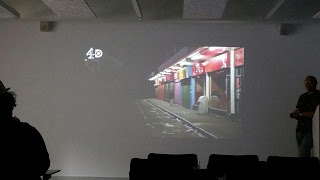 Objectives:
Objectives:Introduction the concept.
How we use it.
Understanding and interpreting it (Semiotics).
Mise en scene is defined as "what is in the scene"
The phrase originated in theatre and is used in TV as it has as much relevance.
4 Key elements of mise en scene:
1) Costume/Makeup - What the visual look of the characters convey.
2) Location/Setting - The environment that a story takes place.
 3) Props - What the character is surrounded by
3) Props - What the character is surrounded by4) Lighting - How it affects the character
Star Wars 1977
Setting - Sci Fi futuristic genre
Costume - Militaristic, classic archetypes (Black vs white)
Lighting - Classic high key, dramatic
Staging - Dark and dramatic
Semiotics: the study of signs and their meaning
Denotation - The sign
Connotation/Signified - The concept meaning or association the sign refers to.
Context in mise en scene:
Something could appear different to what you expect, bad guys could wear white and good guys in black. Whilst it might throw you off from a still of the movie, but if you watch the movie you will know who is the good guy and who is the bad guy. It might be different to what we associate, but we will get to know good from bad very quickly.
 Game of thrones castle scene - mise en scene:
Game of thrones castle scene - mise en scene:Setting - Warm, rich and exotic.
Costume/Makeup - Luxurious and the contrasts.
Lighting - Soft, natural, fill light.
Staging - Dominant female
 Game of thrones barrack scene - mise en scene:
Game of thrones barrack scene - mise en scene:Setting: Cold, austere and masculine
Costume/Makeup: Uniformity
Lighting: Dark,Cold blue and key light
Staging: Status and rank
How can mise en scene help us?
Useful visual shorthand show not tell. It can help define the characters. Defining relationships between characters.

TOWIE - SCRIPTED REALITY
Setting: Hyperrealism, Stage set?(Is it real or not?)
Costume/Makeup: Glamour, Aspirational?(Do we really want to be like them?)
Lighting: High key and dramatic
Staging: Imitates the conventions of a drama.
OBSERVATIONAL DOCUMENTARY - Dispatches - C4
Setting: Authentic locations
Costume/Makeup: Defines social class?
Lighting: Natural lighting, most things are dark.
Realism in mise en scene - the presentation of of art as a simulacrum of a world as exists. Used to convey notions of authenticity, truth and representation.Classicism is the presentation of art as a continuity with past, especially with formal notions of aesthetics, form, design and content.
 Philip Defranco
Philip DefrancoConstructed to emulate a normal bedroom and we can tell his interests from what is hanging up in the back of his shot.
His clothing in his videos signifies that he is blue collar "normal" and not showing off like some multi-millionaires could do. However he sees that this could push away a lot of viewers.
MISE EN SCENE IN DRAMA:
Setting: Film/TV classically used studio sets
Costume/ Makeup: Designed as character specific
Lighting: High key, trying to emulate natural lighting but maybe a little more extreme
Staging: Dramatic
MISE EN SCENE IN DOCUMENTARY:
Setting: Classically uses real locations
Costume/Makeup: Authentic but can be directed
Lighting: Traditionally natural but often artificially designed
Staging: Natural but definitely director specific
--------------------------------------------------
SAS Embassy Siege - First time they were seen in public.
Mise en scene for this scene.
Getting the picture owners permission to use their picture.
Interviews to get a personal view of what was happening
Possible interviews with someone involved, who may now have retired.
This newspaper front page is important because it is an authentic image, not a reconstruction. However a reconstruction of what might have happened inside would be important to any viewer as they can understand much better what actually happened on that day.
If you wanted to get an idea of the SAS, it would be interesting to look at the barracks. However as they are a secret service it makes it very hard to get any proper access to the site.




No comments:
Post a Comment